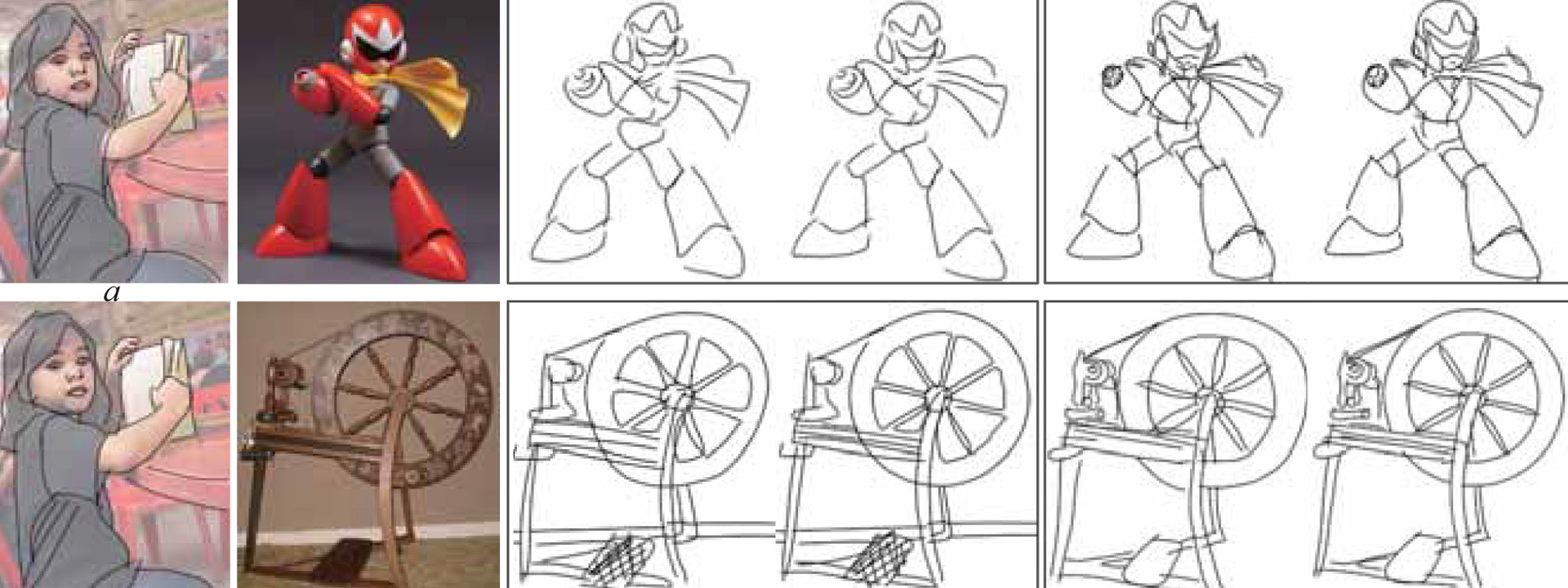“EZ-sketching: three-level optimization for error-tolerant image tracing” by Su, LI, Wang and Fu
Conference:
Type(s):
Title:
- EZ-sketching: three-level optimization for error-tolerant image tracing
Session/Category Title: Non-Photorealistic Rendering
Presenter(s)/Author(s):
Moderator(s):
Abstract:
We present a new image-guided drawing interface called EZ-Sketching, which uses a tracing paradigm and automatically corrects sketch lines roughly traced over an image by analyzing and utilizing the image features being traced. While previous edge snapping methods aim at optimizing individual strokes, we show that a co-analysis of multiple roughly placed nearby strokes better captures the user’s intent. We formulate automatic sketch improvement as a three-level optimization problem and present an efficient solution to it. EZ-Sketching can tolerate errors from various sources such as indirect control and inherently inaccurate input, and works well for sketching on touch devices with small screens using fingers. Our user study confirms that the drawings our approach helped generate show closer resemblance to the traced images, and are often aesthetically more pleasing.
References:
1. Arbelaez, P., Maire, M., Fowlkes, C., and Malik, J. 2011. Contour detection and hierarchical image segmentation. Pattern Analysis and Machine Intelligence, IEEE Transactions on 33, 5, 898–916. Google ScholarDigital Library
2. Bao, B., and Fu, H. 2012. Vectorizing line drawings with near-constant line width. In ICIP 2012.Google Scholar
3. Baran, I., Lehtinen, J., and Popović, J. 2010. Sketching clothoid splines using shortest paths. In Computer Graphics Forum, vol. 29, 655–664.Google ScholarCross Ref
4. Bartolo, A., Camilleri, K. P., Fabri, S. G., Borg, J. C., and Farrugia, P. J. 2007. Scribbles to vectors: preparation of scribble drawings for cad interpretation. In Proceedings of the 4th Eurographics workshop on Sketch-based interfaces and modeling, 123–130. Google ScholarDigital Library
5. Dixon, D., Prasad, M., and Hammond, T. 2010. iCanDraw: using sketch recognition and corrective feedback to assist a user in drawing human faces. In CHI, 897–906. Google ScholarDigital Library
6. Flagg, M., and Rehg, J. M. 2006. Projector-guided painting. In UIST ’06, 235–244. Google ScholarDigital Library
7. Gingold, Y., Vouga, E., Grinspun, E., and Hirsh, H. 2012. Diamonds from the rough: Improving drawing, painting, and singing via crowdsourcing. In Proceedings of the AAAI Workshop on Human Computation (HCOMP).Google Scholar
8. Iarussi, E., Bousseau, A., and Tsandilas, T. 2013. The drawing assistant: Automated drawing guidance and feedback from photographs. In UIST ’13, 183–192. Google ScholarDigital Library
9. Igarashi, T., Matsuoka, S., Kawachiya, S., and Tanaka, H. 1997. Interactive beautification: a technique for rapid geometric design. In UIST ’97, 105–114. Google ScholarDigital Library
10. Kang, H. W., He, W., Chui, C. K., and Chakraborty, U. K. 2005. Interactive sketch generation. The Visual Computer 21, 8-10, 821–830.Google ScholarCross Ref
11. Kang, H., Lee, S., and Chui, C. K. 2007. Coherent line drawing. In NPAR 2007, 43–50. Google ScholarDigital Library
12. Kass, M., Witkin, A., and Terzopoulos, D. 1988. Snakes: Active contour models. International Journal of Computer Vision 1, 4, 321–331.Google ScholarCross Ref
13. Laviole, J., and Hachet, M. 2012. PapARt: interactive 3D graphics and multi-touch augmented paper for artistic creation. In 3DUI.Google Scholar
14. Lee, Y. J., Zitnick, C. L., and Cohen, M. F. 2011. Shadowdraw: real-time user guidance for freehand drawing. ACM Trans. Graph. 30, 27:1–27:10. Google ScholarDigital Library
15. Levi, Z., and Gotsman, C. 2013. D-snake: Image registration by as-similar-as-possible template deformation. Visualization and Computer Graphics, IEEE Transactions on 19, 2, 331–343. Google ScholarDigital Library
16. Limpaecher, A., Feltman, N., Treuille, A., and Cohen, M. 2013. Real-time drawing assistance through crowdsourcing. ACM Trans. Graph. 32, 4, 54:1–54:8. Google ScholarDigital Library
17. Mortensen, E. N., and Barrett, W. A. 1995. Intelligent scissors for image composition. In SIGGRAPH ’95, 191–198. Google ScholarDigital Library
18. Noris, G., Hornung, A., Sumner, R. W., Simmons, M., and Gross, M. 2013. Topology-driven vectorization of clean line drawings. ACM Trans. Graph 32, 1, 4. Google ScholarDigital Library
19. Orbay, G., and Kara, L. B. 2011. Beautification of design sketches using trainable stroke clustering and curve fitting. Visualization and Computer Graphics, IEEE Transactions on 17, 5, 694–708. Google ScholarDigital Library
20. Rivers, A., Adams, A., and Durand, F. 2012. Sculpting by numbers. ACM Trans. Graph. 31, 6, 157:1–157:7. Google ScholarDigital Library
21. Sýkora, D., Dingliana, J., and Collins, S. 2009. Lazy-brush: Flexible painting tool for hand-drawn cartoons. Computer Graphics Forum 28, 2, 599–608.Google ScholarCross Ref
22. Xu, K., Chen, K., Fu, H., Sun, W.-L., and Hu, S.-M. 2013. Sketch2scene: Sketch-based co-retrieval and co-placement of 3d models. ACM Trans. Graph 32, 4, Article No. 123. Google ScholarDigital Library
23. Yang, S. L., Wang, J., and Shapiro, L. 2013. Supervised semantic gradient extraction using linear optimization. In CVPR 2013. Google ScholarDigital Library
24. Zhou, K., Huang, J., Snyder, J., Liu, X., Bao, H., Guo, B., and Shum, H.-Y. 2005. Large mesh deformation using the volumetric graph Laplacian. ACM Trans. Graph. 24, 3, 496–503. Google ScholarDigital Library
25. Zitnick, C. L. 2013. Handwriting beautification using token means. ACM Trans. Graph. 32, 4, 53:1–53:8. Google ScholarDigital Library





